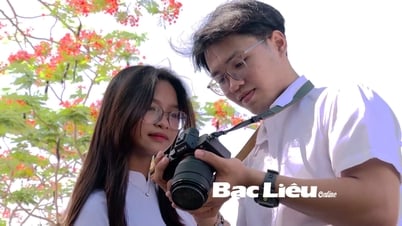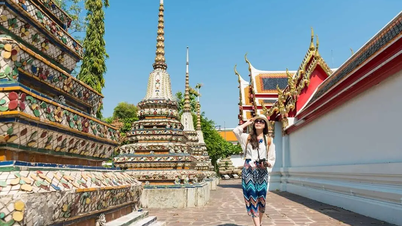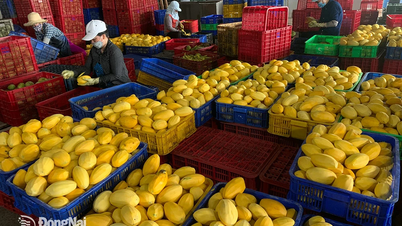The Chapi is a unique traditional musical instrument of the Raglay people in the mountainous district of Bac Ai, Ninh Thuan province. The Chapi has been associated with the Raglay community for many generations, becoming a cultural beauty of the Raglay people in this sunny and windy land. In the flow of modern life, the Chapi is still being preserved and passed down by some artisans in Bac Ai with the hope that the unique sounds of this instrument will resonate forever...
Some traditional musical instruments of the Raglay people include the Chapi (middle).
Spiritual food of the Raglay people
During a meeting and exchange conference for ethnic minority artists in Hanoi , we had the chance to watch and listen to Meritorious Artist Mai Tham from Ma Oai village, Phuoc Thang commune, Bac Ai district, Ninh Thuan province play the Chapi. The artist played the instrument while humming a song in Raglay language that he had memorized since childhood. The sound from the Chapi was rhythmic, sometimes low, sometimes high, echoing the melodies of the mountains and forests.
Meritorious Artist Mai Tham said that in the past, Ma la (a type of gong of the Raglay people), lithophone and Chapi were indispensable spiritual food for the Raglay people. But perhaps the most unique is the Chapi. This is a musical instrument made of bamboo tubes, crafted by Raglay artisans and played in folk festivals, especially during ethnic holidays and Tet such as: Tomb-leaving ceremony, new rice ceremony, going to the fields ceremony, Lunar New Year...
According to Meritorious Artist Mai Tham, for the Raglay people, the Chapi is the instrument of the poor. Any poor person can afford a Chapi, and when sad or happy, the Chapi is always there to accompany them. Because a complete set of Ma la must have from 9 to 12 pieces, and a good old Ma la must be exchanged for a buffalo or two cows. On the contrary, the Chapi can be played by just one day of going to the forest to find bamboo, while the Ma la requires five or seven, or even a dozen people to play.

Meritorious Artist Mai Tham plays the Chapi.
The special thing is that the sound of the Chapi is like a miniature maracas. The sound of the Chapi vibrates, sometimes slowly, sometimes quickly, sometimes loosely, full of emotion. Simple and compact like that, the Chapi follows the Raglai people to every forest, mountain, every village road, so that when happy or sad, everyone can play the instrument.
The Chapi has six melodies with very simple names: Frog melodies, Bird melodies, Forgetting things melodies, Sorrow melodies, or Em o lai anh ve melodies. “The Chapi rhythm is slow and unrestrained, like the leisurely, relaxed demeanor and proud, free steps of the Raglay people,” said Meritorious Artist Mai Tham.
On the outside, the Chapi is an old bamboo tube, about 40cm long, 7-8cm in diameter, with holes punched at both ends. According to Meritorious Artist Mai Tham, to make the Chapi, people have to go into the forest to cut bamboo. The bamboo must be round, with yellow, shiny bark, growing on high hillsides, and the roots do not absorb much water. After using a machete to cut the stem horizontally, cut it into segments, bring it home, then hang it on the kitchen shelf for 3-4 months until the bamboo tube is completely dry and tough before using it to make the instrument. The drier the bamboo is, the better the sound it will produce, and it will avoid termites when used.
Each Chapi has 8 strings, each string is spaced about 2 cm apart. The uniqueness of Chapi is that the strings are made of bamboo. This is also the most difficult part of making a Raglai instrument.
To make Chapi strings, artisans use a knife to cut into the bamboo bark, skillfully separating the bark into four pairs of strings that are evenly spaced but have different thicknesses. Then, they shave the bamboo pieces until smooth, insert them between two parallel strings, and tie them tightly with strings picked from the forest, while working and testing the sound, so that the strings have the best sound.
The Chapi has four holes corresponding to the four frets. The holes are located in the middle of the bamboo body, with two holes at both ends for the sound to escape. When playing the Chapi, the artist must lift the instrument high up near the chest, placing the hollow end against the belly wall to keep the sound inside the instrument. The two hands are used to hold the instrument and to pluck the strings in rhythm.
Because the Chapi melody cannot be written on paper, only the strings produce high and low sounds. That is why people have to play the instrument every day and every night to remember it. Chapi carries the Raglai people's heart. "Our people rarely express their feelings with words, so we often use Chapi to express our feelings" - artist Mai Tham said.
Preserving the unique sound of the Chapi
Nowadays, the festival space is no longer the same as before and due to the influence of new trends, the playing of Chapi is fading away in Raglay villages. Right in the "cradle" of Chapi, very few people know the sound of Chapi and do not know how to play Chapi anymore. That makes those who are passionate about preserving Raglay culture like artisan Mai Tham feel sad.
“Our generation is always worried that the Chapi sound will no longer resound in Raglai community activities, and that no one will know how to play Chapi anymore,” Meritorious Artist Mai Tham worries.
Therefore, preserving the Raglay cultural identity, including preserving the Chapi instrument, is an important task that people with a deep love for national culture like Meritorious Artist Mai Tham always keep in mind.
Chapi of the Raglay people in Ninh Thuan.
Recently, in order to preserve and promote the traditional cultural values of the Raglay people, Ninh Thuan province has developed a "Community Tourism Development Project for the period 2023 - 2026 and vision to 2030" associated with preserving the traditional cultural values of the Raglay people. At the same time, coordinate with relevant agencies to carry out the work of collecting and researching folk arts, reviving and restoring the "cultural space" of the Raglay people. In particular, classes on the use of traditional musical instruments have been opened so that young people can understand and love traditional culture more.
Meritorious Artist Mai Tham not only opened a training center for playing the Ma La and Chapi for people in Phuoc Thang commune at his home, but he also joined artisans Chamalé Âu and Chamalé Liệp to teach the use of traditional musical instruments of Ninh Thuan province. He diligently and meticulously instructed how to play the Chapi and how to distinguish songs to suit different ceremonies and festivals. "If the Raglai people do not study or teach the next generations, musical instruments such as the Chapi, the Khen Bau, the Ma La,... will no longer be known. Therefore, there must be teaching classes like this to preserve the beautiful cultural identity of the Raglai people," Meritorious Artist Mai Tham affirmed.
Through these classes, many Raglay youths learned about and practiced playing the Chapi, becoming members of the local art troupe. This made older artists like Meritorious Artist Mai Tham very excited because there was a younger generation continuing the traditional values of the nation.
With the efforts to preserve the ethnic culture of Ninh Thuan province, currently, at community tourism areas in Bac Ai district, the sound of Chapi has blended with other musical instruments and is becoming an attraction for tourists when coming to the sunny and windy land of Ninh Thuan.
According to Thanh Thuan/Dan Toc Newspaper
Source: https://baophutho.vn/de-tieng-dan-chapi-con-vang-mai-216846.htm


![[Photo] 12th grade students say goodbye at the closing ceremony, preparing to embark on a new journey](https://vphoto.vietnam.vn/thumb/1200x675/vietnam/resource/IMAGE/2025/5/28/42ac3d300d214e7b8db4a03feeed3f6a)

![[Photo] General Secretary To Lam works with the Central Policy and Strategy Committee](https://vphoto.vietnam.vn/thumb/1200x675/vietnam/resource/IMAGE/2025/5/28/7b31a656d8a148d4b7e7ca66463a6894)
![[Photo] Prime Minister Pham Minh Chinh receives a bipartisan delegation of US House of Representatives](https://vphoto.vietnam.vn/thumb/1200x675/vietnam/resource/IMAGE/2025/5/28/468e61546b664d3f98dc75f6a3c2c880)
![[Photo] Vietnamese and Hungarian leaders attend the opening of the exhibition by photographer Bozoky Dezso](https://vphoto.vietnam.vn/thumb/1200x675/vietnam/resource/IMAGE/2025/5/28/b478be84f13042aebc74e077c4756e4b)



















































































Comment (0)